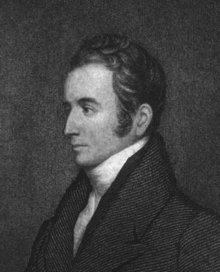Jehudi Ashmun
Jehudi Ashmun | |
|---|---|
 Portrait ca. 1825 | |
| 4th and 6th Colonial Agent of Liberia | |
| In office 8 August 1822 – 2 April 1823 | |
| Preceded by | Elijah Johnson |
| Succeeded by | Elijah Johnson |
| In office 14 August 1823 – 26 March 1828 | |
| Preceded by | Elijah Johnson |
| Succeeded by | Lott Cary |
| Personal details | |
| Born | 21 April 1794 Champlain, New York, U.S. |
| Died | 25 August 1828 (aged 34) New Haven, Connecticut, U.S. |
| Nationality | United States |
Jehudi Ashmun (April 21, 1794 – August 25, 1828) was an American religious leader and social reformer who became involved in the American Colonization Society. He served as the United States government's agent in the Liberia colony and as such its de facto governor for two different terms: one from August 1822 until April 1823, and another from August 1823 until March 1828.
Early life and education
Born in Champlain, New York, Ashmun first studied at Middlebury College in Vermont. He spent his senior year at the University of Vermont and was ordained in Maine as a minister.
Marriage and family
Ashmun married in 1818 and his wife accompanied him to Bangor, where he took his first position.
Career
Ashmun was appointed as the first principal, and one of the first two professors, of the Bangor Theological Seminary in Bangor, Maine. He retained this professorship until 1827, despite leaving the country for a few years.[1][2]
Drawn by other opportunities, Ashmun moved to Washington, DC, where he worked as the editor of an Episcopalian monthly. Interested in the work of the American Colonization Society (ACS), he founded the newspaper The African Intelligencer and wrote about their mission. His articles about the ACS, which was committed to repatriating free blacks to a colony in Liberia, led to his political appointment as representative of the U.S. government to the colony. At the age of 26, Ashmun was the leader in 1822 of a group of settlers and missionaries to Liberia on the ship Elizabeth. His wife went with him but died of malaria in Liberia.
As United States representative to Liberia as well as agent of the ACS, Ashmun effectively became governor of the colony from 1822 to 1828, from ages 28 to 34. He took a leadership role in what he found to be a demoralized colony and helped build the defenses of Monrovia, as well as building up trade. During his tenure in Liberia, Ashmun increased agricultural production, annexed more tribal land from the natives, and exploited commercial opportunities in the interior.
He helped create a constitution for Liberia that enabled blacks to hold positions in the government. This was unlike what happened in the neighboring British colony of Sierra Leone, which was dominated by whites although founded for the resettlement of free blacks from Britain and Upper Canada. Ashmun's letters home and his book, History of the American Colony in Liberia, 1821–1823 (1826) constitute the earliest written history of the Liberia colony.[1][2]
Legacy and honors

- Lincoln University, a historically black college, was originally chartered in 1854 as Ashmun Institute in his honor.
Death
In ill health in Liberia, Ashmun died in New Haven, Connecticut soon after his return to the US. He was interred in Grove Street Cemetery.
Notes
Further reading
- Charles I. Foster, “The Colonization of Free Negroes, in Liberia, 1816–1835”, The Journal of Negro History (1953)
- Ralph Randolph Gurley, Life of Jehudi Ashmun, late colonial agent in Liberia, Boston: J. C. Dunn, 1835
- Frankie Hutton, “Economic Considerations in the American Colonization Society’s Early Effort to Emigrate Free Blacks to Liberia, 1816–36", The Journal of Negro History (1983)
- P. J. Staudenraus, The African Colonization Movement 1816–1865 (New York: Columbia University Press, 1961)
